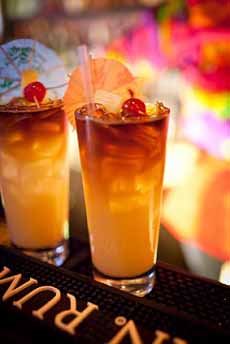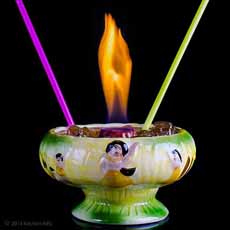Mai Tai History & Recipe For National Mai Tai Day
|
June 30th is National Mai Tai Day, a drink that is attributed by most experts to Victor J. Bergeron, a.k.a. Trader Vic (1902-1984). Bergeron was the founder of the Trader Vic’s restaurant chain that was so popular in the 1950s and 1960s, which grew to some 30 Trader Vic restaurants worldwide, plus a wholesale food products business. Trader Vic and his “amicable rival,” Don The Beachcomber, introduced mainland America to “tiki” drinks: plenty of rum and sweet mixers, garnished with baby orchids and perhaps a mini Japanese paper umbrella. Bergeron, son of a San Francisco grocer, entered the restaurant business at age 32 in 1934—the year following the end of Prohibition. He used $300 of his own money and $800 borrowed from an aunt to open Hinky Dink’s, a hole-in-the-wall restaurant and beer joint in Oakland. He began inventing and improving his vision of South Seas food—largely, the Cantonese cooking he had come across there. To go with the food, he invented exotic, rum-based drinks with catchy names, such as Doctor Funk of Tahiti, Mai Tai, Missionary’s Revenge, Queen’s Park Swizzle, Scorpion, and Sufferin’ Bastard, among others. The original Mai Tai recipe is below. But first, some history. In 1937, Hinky Dink’s morphed into an upscale South Pacific theme restaurant with a menu and Polynesian decor, intended to provide “complete escape and relaxation.” [source] Theme-oriented restaurants had been established a few years before then (the history of theme restaurants), based on concepts from hot rods to fishing villages. Don The Beachcomber, and then Vic Bergeron, pioneered the Polynesian theme restaurant. Polynesian restaurants were known for their “tiki drinks,” so-called because the restaurants were decorated with tiki statues, along with other theme items such as South Seas-style wood surfboards, fake palm trees, and fish-shaped lights floating above, “trapped” in fishing nets. The exotic drinks added excitement to the overall category of rum drinks, which was focused on the Daiquiri, Dark and Stormy, Mojito, and Rum and Coke/Cuba Libre (the Hurricane, Piña Colada, and others had not yet seen the light of day). Others included Navy Grog, invented by Don the Beachcomber in Hollywood in 1944; Planter’s Punch, invented in Jamaica by 1878); Rum Runner, created in the 1950s at the Holiday Isle Tiki Bar in Islamorada, Florida; Tahitian Rum Punch, invented by Don The Beachcomber; and the Zombie, invented by Don the Beachcomber and popularized at the 1939 New York World’s Fair. Tiki-inspired ceramic glasses, mugs, and drink bowls were designed to fan the flames, as it were. Some bowls even had a center well into which Sterno could be poured for flaming drinks. Other drinks were flamed with a tablespoon of high-proof rum, which was added to the surface. The history of the tiki bar is below. The Mai Tai (pronounced my tie), was created in 1944 by Trader Vic. He tested the recipe on two friends from Tahiti, one of whom exclaimed “Maita’i roa a’e”, or “out of this world—the best” in Tahitian. Bergeron shortened that to Mai Tai—“the best.” Trader Vic’s recipe is the one that endured, combining dark and light rums, lime juice, orange curaçao, orgeat syrup (almond-flavored simple syrup), and regular simple syrup. The original had a simple garnish (a mint spring) or none at all. There is another drink called Mai Tai Swizzle, from Don the Beachcomber. It was invented in 1933, but it seems to have disappeared from his menu sometime before 1937 [source]. But the recipe was quite different, augmenting the rum with grapefruit juice, lime juice, Pernod, and bitters. Here’s the recipe. Over the years, Trader Vic’s Mai Tai has been further “developed” by bartenders, into a fruitier and more colorful drink. As with every drink called Margarita or Martini—when in fact the ingredients stray far from those recipes—these recipes “borrow” the Mai Tai name but give you a very different rum drink, with pineapple juice, orange juice, and grenadine. Why? Because fruity drinks are downed more quickly, leading to another and another (i.e., more drinks sold). To add to the colorful drink, a baby orchid and/or miniature Japanese umbrella appeared as garnish; or at least, a pineapple slice, orange slice, and/or maraschino cherry. As one article noted, “The flavor is often dominated by fruit, and that helps hide the heavy taste of alcohol. This is perfect for drinkers who prefer less alcoholic flavor…They end up tasting so good that a person can almost forget how potent they really are.” [source] |
 [1] A Mai Tai based on the original recipe—except for the orchid, a later addition (photo courtesy The Mercury | Atlanta. Here’s the recipe (photo © The Mercury | Atlanta [now closed]).
|
|
|
RECIPE: THE ORIGINAL MAI TAI Bergeron invented the Mai Tai to showcase a favorite aged rum—the 17-year-old J. Wray and Nephew Ltd. Jamaican rum, golden and medium-bodied (the brand is now owned by Campari America). He also used rock candy syrup, which is sweeter and thicker than regular simple syrup: 2 parts sugar and 1 part water instead of a 1:1 ratio (recipe). However, the Mai Tai was such a smash hit that “A couple of years after the cocktail’s invention, the world ran out of the 17-year-old rum…so [Bergeron substituted] a 15-year-old J. Wray and Nephew.” [source] But once that, too, dwindled in supply, Bergeron created a blend of Jamaican rum and aged molasses-based Martinique rum to emulate the Wray and Nephew rum. |
||
 [4] Not an authentic Mai Tai: The original had no orange juice, no umbrella (photo © Flick River).
[6] As tiki culture evolved, so did the drinks—into flaming bowls equivalent to six or more drinks, served with jumbo straws. Here’s the recipe for this Volcano Bowl from Kitchen Riffs). |
Thus, here’s a current approximation of Bergeron’s revised Mai Tai: Ingredients Per Drink *Original recipe: 2 ounces 17-year old J. Wray & Nephew Rum. **Original brand: Holland DeKuyper Orange Curaçao. †Original recipe: 1/4 ounce Trader Vic’s Rock Candy Syrup (sweeter than orgeat, which is almond-flavored simple syrup). ‡Original brand: Garnier Orgeat (orgeat is the preferred simple syrup in France. This brand no longer exists.) SHAKE the ingredients vigorously with the ice. Strain into an ice-filled double-old fashioned glass. Add a sprig of fresh mint Regarding the subsequent fruity, colorful modifications to his drink, Bergeron said: “The flavor of this great rum wasn’t meant to be overpowered with heavy additions of fruit juices and flavorings.” Alas, bar owners and bartenders could care less [source]. Ernest Raymond Beaumont Grant (1907-1989) a Texas native, began to travel the world—including the islands of the Caribbean and the South Pacific—in 1926. A bootlegger during Prohibition, he moved to Hollywood and when Prohibition in 1933, opened a bar called Don’s Beachcomber, the first tiki bar. Grant changed his name to Donn Beach, and in 1937 changed the name of the establishment to Don the Beachcomber. He then opened what became a very popular bar on Hollywood Boulevard in Los Angeles. It was decorated with items from the South Pacific, and Beach developed a cocktail menu that developed “secret recipes” inspired by the many types of rum drinks he had experienced during his years of island travel. In 1934, Victor Bergeron, who had also toured the South Seas, transformed his Oakland, California saloon Hinky Dinks into Trader Vic’s upscale Polynesian bar and restaurant. He created his own menu of rum drinks. Located some 380 miles apart, the two pioneers of “tiki culture” became amicable rivals. Following World War II, the interest in South Pacific culture blossomed and the tiki boom took off. Tiki bars popped up all over the country, each attempting to outshine one another with lavish decor and rum cocktails served in mammoth bowls with floating orchids and tiny paper umbrellas [source]. Both of the original bars expanded into restaurant chains. Don The Beachcomber had 25 locations, the last of which closed in the 1980s (two short-lived locations opened in 2001 and 2004, and a restaurant in Huntington Beach licensed the name in 2009 [source]. |
|
|
Tiki culture peaked in the 1970s, and if you were of drinking age at the time, you may be missing those delightful drinks. So throw together a Mai Tai, and celebrate National Mai Tai Day. |
||




